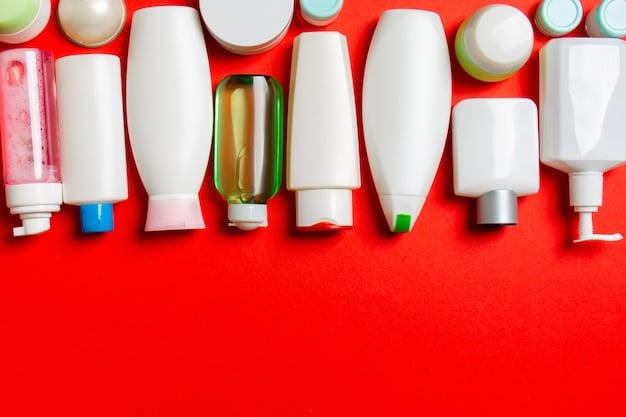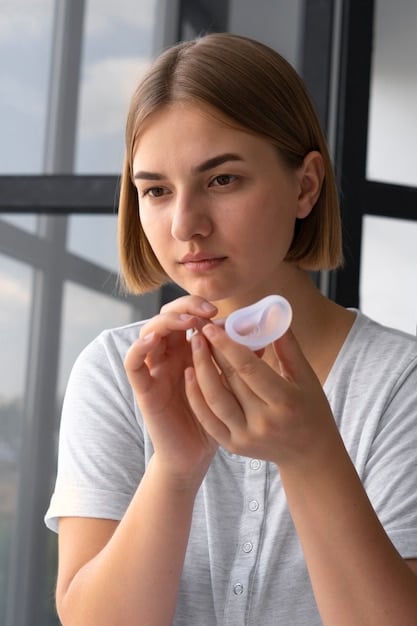Oily Skin Breakthrough: Control Shine & Breakouts in 7 Days

Advertisements
Oily Skin Breakthrough: Control Shine and Breakouts with This 7-Day Routine involves a strategic skincare regimen incorporating gentle cleansing, targeted treatments with salicylic acid or benzoyl peroxide, lightweight hydration, and oil-absorbing masks.
Advertisements
Is oily skin and frequent breakouts ruining your day? Discover the Oily Skin Breakthrough: Control Shine and Breakouts with This 7-Day Routine designed to minimize excess oil, clear blemishes, and promote a healthier complexion in just one week.
Understanding Oily Skin and its Causes
Advertisements
Oily skin, characterized by a greasy or shiny appearance, is a common concern for many. This condition occurs when the sebaceous glands in the skin produce excess sebum, an oily substance that helps keep the skin hydrated. Understanding the root causes of oily skin is the first step in effectively managing it.
Genetic Predisposition
Genetics play a significant role in determining your skin type. If your parents have oily skin, you’re more likely to have it too. This genetic predisposition influences the size and activity of your sebaceous glands.
Hormonal Factors
Hormonal fluctuations can significantly impact sebum production. During puberty, hormonal changes often lead to increased oil production, resulting in breakouts. Similarly, hormonal changes during menstruation, pregnancy, and menopause can also affect skin oiliness.

Environmental Factors
Environmental conditions, such as humidity and temperature, can exacerbate oily skin. High humidity can trap moisture on the skin, leading to increased sebum production. Similarly, hot weather can stimulate sebaceous glands, contributing to oiliness.
- Diet: Certain foods, particularly those high in processed sugars and unhealthy fats, can trigger inflammation and increase sebum production.
- Stress: Stress can trigger hormonal imbalances, leading to increased oil production and breakouts.
- Skincare Products: Using heavy, comedogenic (pore-clogging) skincare products can worsen oily skin.
Identifying and addressing the underlying causes of your oily skin is essential for developing an effective skincare routine. By understanding these factors, you can make informed choices about your skincare habits and products.
The Foundation: Cleansing and Exfoliating
The cornerstone of any effective skincare routine for oily skin is proper cleansing and exfoliation. These steps help remove excess oil, dirt, and dead skin cells that can clog pores and lead to breakouts. Choosing the right products and techniques can make a significant difference in managing oily skin.
Choosing the Right Cleanser
Opt for a gentle, foaming cleanser specifically formulated for oily skin. Look for ingredients like salicylic acid or tea tree oil, which can help unclog pores and reduce inflammation. Avoid harsh cleansers that can strip the skin of its natural oils, as this can lead to increased oil production as the skin tries to compensate.
The Importance of Exfoliation
Exfoliation helps remove dead skin cells that can clog pores and contribute to breakouts. There are two main types of exfoliation: physical and chemical. Physical exfoliants include scrubs with small beads or brushes, while chemical exfoliants utilize ingredients like alpha-hydroxy acids (AHAs) or beta-hydroxy acids (BHAs).

Effective Cleansing Techniques
When cleansing, use lukewarm water and gently massage the cleanser onto your skin in circular motions for about 30-60 seconds. Rinse thoroughly and pat your skin dry with a soft towel. Avoid rubbing your skin, as this can irritate and stimulate oil production.
- Frequency: Cleanse your face twice daily, in the morning and evening, to remove accumulated oil and impurities.
- Double Cleansing: Consider double cleansing in the evening, especially if you wear makeup. Start with an oil-based cleanser to remove makeup and sunscreen, followed by a gentle foaming cleanser to remove any remaining residue.
- Gentle Exfoliation: Exfoliate 2-3 times per week to avoid over-exfoliating and irritating your skin.
Proper cleansing and exfoliation are essential for maintaining clear, healthy skin. By incorporating these steps into your daily routine, you can effectively manage oily skin and prevent breakouts.
Targeted Treatments: Serums and Spot Treatments
Targeted treatments, such as serums and spot treatments, can play a crucial role in addressing specific concerns associated with oily skin, such as breakouts, inflammation, and hyperpigmentation. These products contain concentrated active ingredients that can deliver noticeable results when used correctly.
The Power of Serums
Serums are lightweight, fast-absorbing skincare products that contain a high concentration of active ingredients. For oily skin, serums containing ingredients like niacinamide, vitamin C, or hyaluronic acid can be particularly beneficial.
Effective Spot Treatments
Spot treatments are designed to target individual blemishes and can be incredibly effective in reducing inflammation and promoting healing. Look for spot treatments containing benzoyl peroxide, salicylic acid, or tea tree oil.
Choosing the Right Ingredients
When selecting serums and spot treatments, pay attention to the ingredient list. Niacinamide can help regulate sebum production, reduce inflammation, and minimize the appearance of pores. Vitamin C is a powerful antioxidant that can brighten the skin and protect it from environmental damage. Hyaluronic acid is a humectant that can draw moisture into the skin without adding oil.
- Application: Apply serums to clean, dry skin before applying moisturizer. Use a small amount (usually a few drops) and gently massage it into your skin.
- Spot Treatment Application: Apply spot treatments directly to blemishes after cleansing and before moisturizing. Use a cotton swab to apply a thin layer of product to the affected area.
- Consistency: Use serums and spot treatments consistently to see the best results.
Targeted treatments can significantly improve the appearance and health of oily skin. By incorporating these products into your routine, you can effectively address specific concerns and achieve a clearer, more balanced complexion.
Hydration is Key: Choosing the Right Moisturizer
Many people with oily skin mistakenly believe that they don’t need to moisturize. However, proper hydration is essential for maintaining healthy skin, regardless of your skin type. Skipping moisturizer can lead to dehydration, which can actually trigger increased oil production as the skin tries to compensate.
Why Moisturizing is Important for Oily Skin
When the skin is dehydrated, it becomes more prone to inflammation and irritation. This can lead to increased sebum production and breakouts. Moisturizing helps to maintain the skin’s barrier function, preventing moisture loss and protecting it from environmental aggressors.
Ingredients to Look For
Opt for lightweight, non-comedogenic moisturizers that are specifically formulated for oily skin. Look for ingredients like hyaluronic acid, glycerin, or aloe vera, which can provide hydration without clogging pores. Avoid heavy creams and oils that can exacerbate oiliness.
Application Techniques
Apply moisturizer to clean, slightly damp skin to help lock in moisture. Use a small amount and gently massage it into your skin until it’s fully absorbed. Focus on areas that tend to be drier, such as the cheeks and forehead.
- Gel-Based Moisturizers: These are lightweight and absorb quickly, making them an excellent choice for oily skin.
- Lotion Moisturizers: Look for lotions that are oil-free and non-comedogenic.
- Application Frequency: Moisturize twice daily, in the morning and evening, to keep your skin hydrated and balanced.
Proper hydration is essential for maintaining healthy, balanced skin. By choosing the right moisturizer and incorporating it into your daily routine, you can effectively manage oily skin and prevent breakouts.
Masking for Oil Control: Clay and Charcoal Masks
Masks can be a valuable addition to your skincare routine, providing targeted treatment for specific concerns. For oily skin, clay and charcoal masks are particularly effective at absorbing excess oil, unclogging pores, and reducing inflammation. Incorporating masks into your routine 1-2 times per week can help maintain a clear, balanced complexion.
The Benefits of Clay Masks
Clay masks are formulated with natural clays, such as bentonite or kaolin, which have excellent oil-absorbing properties. These masks work by drawing out impurities and excess oil from the pores, leaving the skin feeling clean and refreshed.
The Benefits of Charcoal Masks
Charcoal masks contain activated charcoal, which is known for its ability to absorb toxins and impurities. These masks can help unclog pores, reduce inflammation, and minimize the appearance of blackheads.
How to Use Masks Effectively
Apply a thin, even layer of the mask to clean, dry skin, avoiding the delicate eye area. Leave the mask on for the amount of time recommended on the product label, usually 10-15 minutes. Rinse thoroughly with lukewarm water and pat your skin dry.
- Frequency: Use masks 1-2 times per week for best results.
- Combination: You can alternate between clay and charcoal masks, or use them in combination, depending on your skin’s needs.
- Moisturize: Always follow up with a moisturizer after using a mask to prevent dryness.
Masks can be a powerful tool in managing oily skin and preventing breakouts. By incorporating clay and charcoal masks into your routine, you can effectively absorb excess oil, unclog pores, and achieve a clearer, more balanced complexion.
Sun Protection: Choosing the Right Sunscreen
Protecting your skin from the sun is crucial, regardless of your skin type. Sun damage can lead to premature aging, hyperpigmentation, and an increased risk of skin cancer. Choosing the right sunscreen for oily skin can be challenging, but there are many lightweight, non-comedogenic options available.
The Importance of Sunscreen for Oily Skin
Sunscreen helps protect the skin from harmful UV rays, which can damage skin cells and lead to inflammation and breakouts. It’s important to wear sunscreen every day, even on cloudy days, as UV rays can penetrate clouds.
Ingredients to Look For
Opt for oil-free, non-comedogenic sunscreens that are specifically formulated for oily skin. Look for ingredients like zinc oxide or titanium dioxide, which are mineral sunscreens that provide broad-spectrum protection without clogging pores. Avoid heavy creams and oils that can exacerbate oiliness.
Application Techniques
Apply sunscreen liberally to all exposed skin at least 15 minutes before sun exposure. Reapply every two hours, or more often if you’re sweating or swimming.
- Gel-Based Sunscreens: These are lightweight and absorb quickly, making them an excellent choice for oily skin.
- Matte Finish Sunscreens: Look for sunscreens that have a matte finish to help control shine.
- Daily Application: Make sunscreen a part of your daily skincare routine, even if you’re not spending a lot of time outdoors.
Sun protection is an essential part of any skincare routine. By choosing the right sunscreen and incorporating it into your daily routine, you can protect your skin from sun damage and maintain a healthy, balanced complexion.
| Key Point | Brief Description |
|---|---|
| 💧 Gentle Cleansing | Removes excess oil without stripping skin. |
| 🌱 Targeted Treatment | Addresses breakouts with salicylic acid or benzoyl peroxide. |
| 🧴 Lightweight Hydration | Maintains skin balance with non-comedogenic moisturizers. |
| ☀️ Daily Sunscreen | Protects from sun damage with oil-free formulas. |
Clear Skin in 7 Days: Oily Skin Routine FAQs
▼
Oily skin is typically caused by overactive sebaceous glands, leading to excess sebum production. Genetics, hormones, diet, and environmental factors can all contribute to oily skin.
▼
It’s recommended to cleanse oily skin twice a day, once in the morning and once in the evening, to remove excess oil, dirt, and impurities.
▼
No, moisturizing is essential for oily skin. Choose a lightweight, non-comedogenic moisturizer to hydrate the skin without clogging pores and exacerbating oiliness.
▼
Use blotting papers to gently absorb excess oil throughout the day. You can also use a mattifying primer under your makeup to control shine.
▼
Both clay and charcoal masks are beneficial for oily skin. Clay masks absorb excess oil and impurities, while charcoal masks detoxify and unclog pores. You can alternate between the two.
Conclusion
Mastering a 7-day routine to combat oily skin and breakouts involves consistent care, targeting excess oil, hydration, and sun protection. By following these steps, you can achieve a clearer, more balanced complexion and maintain healthier skin.





